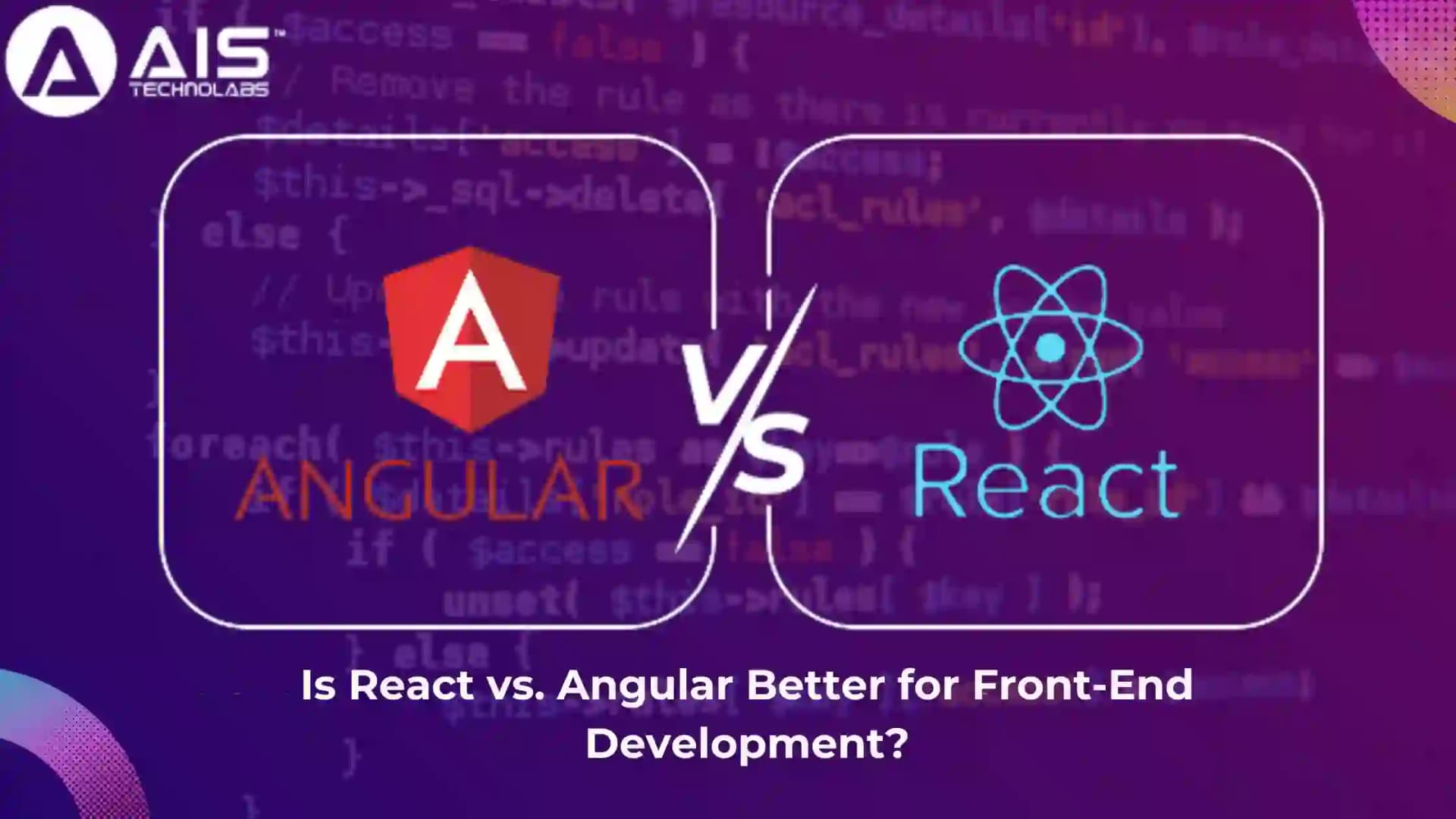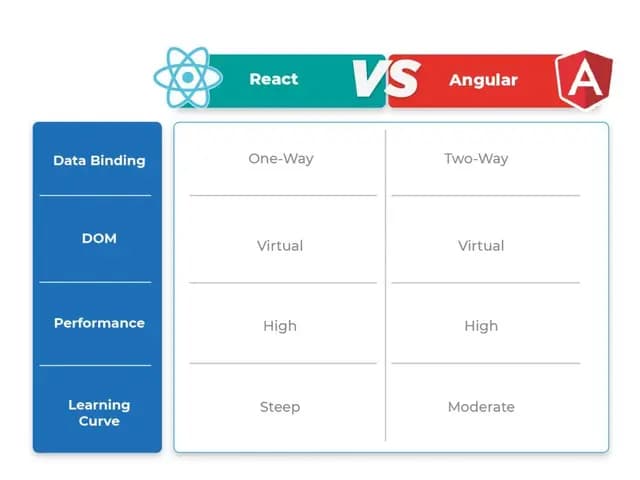Table of Content
(500 views)

Understanding Front-End Development
In the world of Web Development, Front-end development plays an imperative role in building a user experience. It means that part of web development which deals with everything users interact with on a website or application-a user interface, buttons, forms, navigation menus,
In the ecosystem of front-end development, there are two leading names: React and Angular. Both have very wide recognition and are supported by the largest technology giants, such as Facebook and Google, respectively. These are the leading tools for high load web development and performance, but they have their positives and negatives. In case you are choosing between React and Angular for your next project, this article will compare these frameworks against each other across several key factors.
What is React?
React is an open-source JavaScript library developed by Facebook for building user interfaces with a component-based architecture. It's going to make the breakdown of UIs into reusable components way easier and will help the developers handle applications quite easily.
Among the fantastic features that React development includes is the Virtual DOM. It optimizes performance by reducing re-renders, updating only the parts of the page that have changed. This results in faster and more efficient updates, improving the speed of applications that dynamically change state. Additionally, React development is often paired with libraries for managing state and routing, enhancing its flexibility and customization options.
Key Features of React:
- Component-based architecture for modular UI.
- Virtual DOM for faster performance.
- A declarative approach to UI rendering.
- Integration-friendly with third-party libraries.
What is Angular?
Angular is a full-fledged front-end framework developed by Google. Unlike React, which focuses primarily on the view layer, Angular provides a comprehensive solution for building dynamic web applications. It includes built-in tools for routing, forms, HTTP requests, and dependency injection.
AngularJS development uses JavaScript, providing a flexible framework for building dynamic web applications with two-way data binding, which ensures synchronization between the model and view. AngularJS development follows the MVC pattern, where application logic is split into three interconnected parts, enabling developers to build structured and maintainable codebases for complex applications.
Key Features of Angular:
- A complete framework for building full applications.
- Built-in solutions for routing, forms, and HTTP handling.
- TypeScript for better type safety and debugging.
- Supports two-way data binding for easier UI management.
Key Differences Between React and Angular
1. Architecture
- React: Follows a component-based architecture, where developers create self-contained components for the UI. It allows flexibility in choosing other tools for routing and state management.
- Angular: Uses MVC architecture, providing a more structured and opinionated approach. Angular comes with integrated solutions, offering everything developers need in one place.
- React: React uses JSX, which combines HTML and JavaScript. JSX provides a JavaScript-centric approach to building UI components.
- Angular: Angular relies on HTML templates and TypeScript to create the UI. TypeScript’s static typing improves code organization and helps manage large-scale applications.
- React: React focuses on the view layer and allows developers to choose additional libraries for other aspects of development (like React Router for routing or Redux for state management).
- Angular: Angular provides an all-in-one solution with built-in features for routing, forms, HTTP handling, and state management, making it a one-stop solution for large applications.
React vs. Angular: Performance Comparison
Both React and Angular are optimized for high performance, but their approaches differ:
React: With its Virtual DOM, React reduces the need to re-render the entire page by updating only the changed components. This provides fast and efficient UI updates, particularly in dynamic applications.
- Angular: Angular uses a real DOM, meaning it re-renders the entire UI when data changes. However, Angular offers performance optimizations like OnPush change detection and lazy loading to improve performance, especially in complex applications.
Ease of Learning and Developer Experience
- React: React is relatively easy to learn for ReactJS developers who are familiar with JavaScript. Its component-based architecture and declarative syntax make it intuitive for building UI. However, as your project grows, managing state and side effects can become more complex without additional libraries like Redux.
- Angular: Angular, being a complete framework, comes with a steeper learning curve. AngularJS Developers must learn TypeScript, decorators, modules, and advanced concepts like dependency injection and RxJS (for handling asynchronous data). While Angular’s feature-rich ecosystem can speed up large-scale development, it can overwhelm beginners.
React vs. Angular: Flexibility and Scalability
- React: React development is highly flexible. It is suitable for small and large applications, and its component-based structure allows developers to create highly modular and maintainable code. You have the freedom to choose the tools you need for your project, making React an excellent choice for teams who want flexibility and customization.
- Angular is more opinionated, in that it comes with a set structure and with built-in tools for routing, forms, and HTTP handling. This is great for large-scale enterprise applications, but for projects smaller than that, which do not need the full feature set, it may feel a bit too structured
SEO-Friendliness and Server-Side Rendering (SSR)
Both React and Angular can be optimized for SEO and Server-Side Rendering (SSR), but their approaches differ:
- React: React’s client-side rendering can pose SEO challenges since search engines may struggle to index dynamic content. However, frameworks like Next.js solve this problem by enabling SSR and improving SEO.
- Angular: Angular supports Angular Universal, a tool for SSR out of the box. It allows pages to be rendered on the server before sending them to the client, ensuring that search engines can index the fully rendered page, improving SEO.
Which is Faster? React or Angular?
In most cases, React tends to be faster than Angular, thanks to its Virtual DOM, which efficiently updates only the parts of the UI that have changed. This results in smoother and faster performance, especially in highly dynamic applications.
Angular, on the other hand, uses a real DOM, which can be slower when rendering large applications or when there are frequent data changes. However, Angular’s OnPush change detection and lazy loading help mitigate performance issues.
When to Choose React or Angular?

So, when selecting between React and Angular, your project should indicate your needs. React is a lightweight, flexible library perfect for dynamic user interfaces and SPAs. It's ideal for smaller projects or when you want more control over tools. Angular, with its built-in features of dependency injection and two-way data binding, is better for large-scale applications with a full-featured framework. Go with React for flexibility and Angular for structured, enterprise-level development. Choose according to your project's size and complexity.
Choose React if:
- You want flexibility and don’t need a rigid framework.
- You’re building dynamic UIs and need fast rendering and performance.
- You want to integrate with other libraries for routing and state management.
- Your team is comfortable with JavaScript and JSX.
Choose Angular if:
- You’re developing a large-scale enterprise application that requires a full-fledged framework.
- You need two-way data binding and dependency injection for easier testing and maintainability.
- Your project demands TypeScript for improved code quality and maintainability.
- You require SSR out of the box for SEO purposes.
React vs. Angular in the Real World
React in Action:
React is widely used by companies like Facebook, Instagram, and Netflix. It excels in projects that require dynamic UIs and frequent updates, especially where performance is a top priority.
Angular in Action:
Angular is preferred by companies like Google, Microsoft, and IBM, particularly for building large-scale enterprise applications. Angular’s integrated solution is a good fit for complex applications that require strong scalability and maintainability.
React is widely used by companies like Facebook, Instagram, and Netflix. It excels in projects that require dynamic UIs and frequent updates, especially where performance is a top priority.
Angular in Action:
Angular is preferred by companies like Google, Microsoft, and IBM, particularly for building large-scale enterprise applications. Angular’s integrated solution is a good fit for complex applications that require strong scalability and maintainability.
The Future of React and Angular
Both React and Angular are poised for continued growth:
- React: React’s ecosystem is growing with improvements like React Server Components and concurrent rendering, making it even more powerful for building modern web apps.
- Angular: Angular continues to evolve, with updates like Ivy, a new rendering engine, and optimizations focused on performance and reducing bundle sizes.
Conclusion: React or Angular – Which One to Choose?
The choice between React and Angular depends on what exactly your project requires. If you want a flexible and performance-oriented solution for your project, has great community and third-party support, then React is the way to go. However, if you are building an enterprise application needing a full-featured, opinionated framework offering out-of-the-box solutions for routing, forms, and HTTP handling, then Angular is the right choice.
At AIS Technolabs, we see both frameworks excel at building modern web apps. Pick based on your project needs, team skills, and SEO goals - you can't go wrong with either.
FAQs
Ans.
Both React and Angular have their strengths. React is better for lightweight, fast, and flexible applications, while Angular is ideal for large-scale, structured applications with built-in features.
Ans.
Yes, React is generally faster than Angular because it uses a Virtual DOM, which optimizes updates and improves performance. Angular's Real DOM can sometimes slow down complex applications.
Ans.
React is easier to learn, especially for developers familiar with JavaScript. Angular has a steeper learning curve due to its use of TypeScript and additional concepts like dependency injection.
Ans.
Use Angular if you're building a large-scale enterprise application, require built-in security, or need features like routing and form validation without external libraries.
Ans.
While it’s technically possible, it's uncommon. React and Angular have different architectures and are usually used separately in different projects.